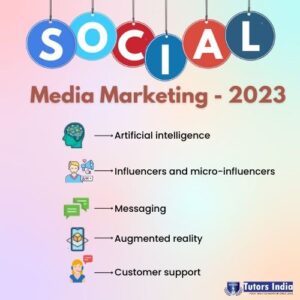THE FUTURE TRENDS OF SOCIAL MEDIA IN MARKETING
Introduction
The significance of Social media in business has advanced. What was once a luxury is now a commonplace marketing strategy. In fact, social media is used by more than half of the world’s population. And recently, people have turned to social media more than ever before to stay in touch with friends and family because they are unable to socialise due to the COVID-19 pandemic (Appel et al., 2020).
This blog will look into the most recent social media marketing trends in 2023 and how they will affect how businesses engage with (and market to) their target audiences.
What’s the future of social media marketing?
Social media is not simply a smattering of applications with newsfeeds and static ads anymore. The ability to communicate with consumers and companies through a variety of channels has been made possible by new technologies: 
The key reason why video advertising have a 7.5x greater click-through rate than display ads is because they give advertisers an opportunity to engage customers with dynamic material that can stand out above all the conventional static content that people have been exposed to for years.
Impacts of artificial intelligence in enhancing customer engagement are developing quickly. For instance, TikTok is well known for its short, amateur videos, which are very well liked by younger users. Thousands of films from every conceivable type of business are available on other platforms, such as YouTube and Instagram (Zahay, 2021)
It’s critical for marketers looking to engage consumers to recognize how video trends are shifting and how their content may adapt to suit these demands across their various targeted customers.
Artificial intelligence
Marketers use artificial intelligence (AI) to enable computers to make decisions that are comparable to those made by humans without direct human intervention. This technology makes it feasible to give tailored, personalised information that is not attainable with conventional marketing strategies.
With the use of chatbots, for instance, marketers may “speak” to customers about their goods or services without the need of a sizable human sales force. Personalized promotions, general brand questions, and even order acceptance and processing are all done by chatbots.
This strategy replicates the experience of a typical in-store salesperson online. When done effectively, customers can contact a company at any hour of the day and feel like they are interacting with a real person.
Also, the marketing experts utilizes AB testing tools which is also known as split testing or bucket testing is a method of comparing two versions of a webpage or app against each other to determine which one performs better (Koning et al., 2020).
Influencers and micro-influencers
On Instagram, there are currently over 500,000 influencers. Influencers are users of social media, frequently Instagram, who have sizable followings and frequently work in a particular specialty.
Through sponsored content, in which a brand collaborates with or pays an expert to talk about or support a particular product or service, social media bloggers give marketers a means to get their brands in front of customers (Wang et al., 2022).
Micro-influencers in Instagram, make up about 81% of the influencers. These influencers have followers ranging from 15,000 to 100,000. Although larger businesses frequently ignore them, they frequently have incredibly engaged audiences, which may also make them cost-effective.
Stories
Like Instagram, Snapchat, and Facebook’s Stories feature allows users to publish brief videos that their followers and friends may view. With more than 500 million daily users, Stories has well overtaken Snapchat popularity.
Facebook/Instagram Stories provide you the chance to attract public’s attention at a time when they might not otherwise have seen your business.
If your company already has Instagram followers, you can publish your own Stories to promote your business. Additionally, you can display sponsored adverts during the breaks between video as viewers are watching them. Both are effective strategies for grabbing this sizable for customer’s attention (Zhao et al., 2021).
Messaging
Although using AI chatbots to interact with customers has already been addressed, there are still a variety of different ways that customers might like to communicate with brands directly through direct messaging channels.
For example, consumers can contact brands via Instagram’s direct message (DM) feature to get additional information about a good or service. A high-value strategy to attract interested clients is to have someone on hand to really answer to inquiries and engage with their interests.
It may seem difficult to manage all these various messaging channels with a tiny sales and support staff. To ensure that customers receive a response, you may rapidly switch between several platforms thanks to tools like Zendesk that can combine and manage these channels.
Augmented reality
In augmented reality (AR), digital experiences are overlaid on top of the physical world using computers and screens. Although a significant AR platform has yet to gain widespread traction, innovations like Oculus are demonstrating the potential benefits this might offer businesses and marketers.
For instance, if a customer were to wear a headset while strolling down the street, a nearby bar or restaurants could feed them information about deals as they pass the actual structure.
Some smartphones feature capability that enables technical engineers to overlay digital content onto the live camera, which is more immediately useful. Customers can use this option to browse Ikea’s items from the comfort of their own homes. Over the ensuing years, this technology ought to become more widely accessible.
Customer support
Although new technologies are fantastic, don’t discount conventional customer care. Consumers will always have inquiries that can only be answered by a human with considering the privacy of their data (Bleier et al., 2020).
Today’s online world differs in that customers expect brands to respond to them on the platform they’re using, so businesses must be able to communicate via email, Instagram direct messages, and standard phone calls.
Embrace the future of social media marketing!
It’s important for businesses to interact with customers across all these channels as social media marketing is changing quickly. Because of this, it’s crucial that your e-commerce platform can interface with all of these different systems to give your customers a seamless experience.
Therefore, to know more about these changes, Tutors India experts can guide the best in writing your master’s dissertation based on your preferred domain.
References
Appel, G., Grewal, L., Hadi, R., & Stephen, A. T. (2020). The future of social media in marketing. Journal of the Academy of Marketing Science, 48(1), 79–95.
Bleier, A., Goldfarb, A., & Tucker, C. (2020). Consumer privacy and the future of data-based innovation and marketing. International Journal of Research in Marketing, 37(3), 466–480.
Koning, R., Hasan, S., & Chatterji, A. (2020). Digital experimentation and startup performance: Evidence from a/b testing. Available at SSRN.
Wang, S., Gan, T., Liu, Y., Zhang, L., Wu, J., & Nie, L. (2022). Discover Micro-Influencers for Brands via Better Understanding. IEEE Transactions on Multimedia, 24, 2595–2605.
Zahay, D. (2021). Advancing research in digital and social media marketing. Journal of Marketing Theory and Practice, 29(1), 125–139.
Zhao, H., Huang, Y., & Wang, Z. (2021). Comparison between social media and social networks in marketing research: a bibliometric view. Nankai Business Review International, 12(1), 122–151.

 Previous Post
Previous Post Next Post
Next Post